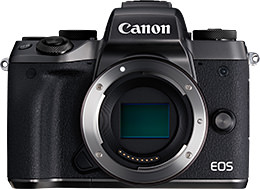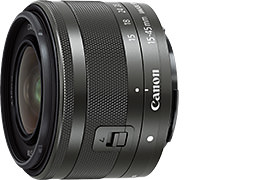EF-M15-45mm f/3.5-6.3 IS STM Review: Enhanced Photographic Possibilities within Lightweight 130g Body
Covering a wide angle to mid-telephoto range, the compact EF-M15-45mm f/3.5-6.3 IS STM, a standard zoom lens for EOS M-series mirrorless cameras, possesses excellent resolving power and weighs only an approximate 130g. In the following, we introduce its features in further detail. (Reported by: Kazuo Nakahara)

Expand your photographic possibilities with this one lens
The EF-M15-45mm f/3.5-6.3 IS STM is a very handy lens which covers a broad focal range of 24mm at the wide angle end to 72mm at the mid telephoto end, at a 35mm-equivalent. Featuring a retraction mechanism, it measures a length of 44.5mm when the lens is retracted. Weighing no more than approximately 130g, it still managed to feature a solid lens construction of 10 elements in 9 groups, including 3 aspheric lens elements. Upon testing, within its range of a wide angle to standard focal length, it produces extremely sharp results at its mid-range with a maximum aperture, and demonstrates a resolving power more than sufficient to bring out the high resolution of the EOS M5.
Although there may be very slight aberration observed around the edges, it is not an issue as any chromatic aberration is completely corrected in the camera. It gives a soft-effect feel to pictures when shooting at the telephoto end, but is also capable of producing sharp image results when you narrow the aperture to about f/11. Updating it with the latest firmware (2.0.0), also makes it possible to utilise Combination IS, which corrects both optical and digital camera shake during movie shooting. Furthermore, when shooting stills, I observed up to 4 stops of image stabilisation, which effectively prevented blurring due to camera shake.
The lens should be more than adequate for street photography at night when used together with the EOS M5, which has high ISO speed, although images shot with f/6.3 at the telephoto end were just a little dark. The closest focusing distance of 25cm, makes it easy to take close up photos of food or ornaments and accessories. The lens also effectively resists backlight, and does not cause major deterioration in contrast when shooting in backlight. Furthermore, the lens operates on STM, which enables silent AF operation at a very high speed.

EOS M5/ EF-M15-45mm f/3.5-6.3 IS STM/ FL: 45mm (72mm equivalent)/ Aperture-priority AE (f/6.3, 1/60 sec, EV+0.3)/ ISO 200/ WB: Auto
I shot the storefront of a shop selling a variety of colourful goods, using bokeh and the compression effect from the telephoto zoom. At an aperture of f/6.3 at the telephoto end, getting closer to the subject makes it very easy to create the bokeh effect. In the resulting picture, the colours are portrayed vividly and accurately.

EOS M5/ EF-M15-45mm f/3.5-6.3 IS STM/ FL: 45mm (72mm equivalent)/ Aperture-priority AE (f/8, 1/100 sec, EV±0)/ ISO 800/ WB: Daylight
With a short closest focusing distance of 25cm, the lens is adept at shooting small objects or food placed on the table. In addition to producing a creamy, even bokeh in the background, it also creates distinctly round bokeh circles near the edges of the screen. As we can see, regardless of whether the subject is nearby or further away, this lens is perfectly capable of capturing them with various interesting effects.

EOS M5/ EF-M15-45mm f/3.5-6.3 IS STM/ FL: 15mm (24mm equivalent)/ Aperture-priority AE (f/11, 1/200 sec, EV+0.3)/ ISO 100/ WB: Auto
A wide, extensive angle of view at a 24mm equivalent enables you to easily depict more of the sky in your landscape photos. A notable feature of this lens is its ability to capture even a window on a distant building in high resolution. Despite the strong sunlight, the captured image boasts clear, balanced contrasts.

EOS M5/ EF-M15-45mm f/3.5-6.3 IS STM/ FL: 28mm (42mm equivalent)/ Aperture-priority AE (f/5.6, 1/400 sec, EV+0.3)/ ISO 100/ WB: Auto
I captured the fleeting shadows of people walking on the street. It helped that this is a lens which shoots quickly. With its swift AF, it captures the momentary photo opportunities crucial to street photography.
Usage Tip #1: A 3mm difference in focal length is a big deal! Show the expanse of a scene using the wide angle end
There are other standard zoom lenses in the EF-M series, such as the EF-M18-55mm f/3.5-5.6 IS STM. Contrary to what some may believe, a disparity of 3mm at the wide angle end can make a huge difference. This 3mm difference is actually approximately 5mm when you convert to 35mm-film equivalent terms—which means there is a massive contrast in the range it is able to show. The shorter the wide-angle end focal length, the wider the area the lens is capable or portraying and the more obvious the perspective exaggeration effect—a feature usually associated with wide-angle lenses, and which can give your images a unique flavour.
A much wider angle compared to shooting at 18mm

EOS M5/ EF-M15-45mm f/3.5-6.3 IS STM/ FL: 15mm (24mm equivalent)/ Aperture-priority AE (f/5.6, 1/160 sec, EV±0)/ ISO 100/ WB: Auto
I shot at 15mm with a low angle very close to the ground. I got as close as possible to the tower, which created an exaggerated perspective unique to wide-angle features, and was able to portray the impact of the tower soaring high up to the sky.


(Left)
Shooting at 15mm
EOS M5/ EF-M15-45mm f/3.5-6.3 IS STM/ FL: 15mm (24mm equivalent)/ Aperture-priority AE (f/5.6, 1/320 sec, EV±0)/ ISO 100/ WB: Auto
This was also shot at 15mm, but at eye level, which creates a less obvious effect of perspective on the tower. The tower doesn’t have as much of an impact as a result, which goes to show the importance of camera angle in portraying your subjects.
(Right)
Shooting at 18mm
EOS M5/ EF-M15-45mm f/3.5-6.3 IS STM/ FL: 18mm (29mm equivalent)/ Aperture-priority AE (f/5.6, 1/125 sec, EV±0)/ ISO 100/ WB: Auto
Shooting at the same spot at 18mm completely cuts off the view on the upper part of the tower. You can see how significant the difference is when you compare the area captured.
Usage Tip #2: Use a centre composition to make the subject stand out
In addition to focusing on the subject itself, you can also further emphasise it by exaggerating perspective distances between the subject and its surroundings. For scenes that have a sense of depth, the wider the angle, the more the view appears to converge towards a point. Therefore, placing the subject close to the vanishing point, makes it easy to draw the viewer’s attention. Combining this with a centre composition further emphasizes the effect.


(Left)
Shooting at 15mm
EOS M5/ EF-M15-45mm f/3.5-6.3 IS STM/ FL: 15mm (24mm equivalent)/ Aperture-priority AE (f/5.6, 1/60 sec, EV±0)/ ISO 320/ WB: Auto
I shot the long, extended escalator at the wide-angle end of 15mm. Since all four sides of the picture clearly converge towards the centre, the viewer’s gaze is naturally directed toward the area of the exit.
(Right)
Shooting at 18mm
EOS M5/ EF-M15-45mm f/3.5-6.3 IS STM/ FL: 18mm (29mm equivalent)/ Aperture-priority AE (f/5.6, 1/60 sec, EV±0)/ ISO 250/ WB: Auto
I shot at the same spot at 18mm. Although the subject itself appeared larger, the perspective exaggeration effect on the surroundings is smaller, which makes it more difficult to direct the viewer’s gaze.
A silent motor operation makes it perfect for shooting videos
For the EF-M15-45mm f/3.5-6.3 IS STM, the sound produced when the AF operates is so quiet it is barely audible unless you place your ears close to the lens, which makes it suitable for shooting videos. Although the outer construction has been designed to be very light, and is mostly made of plastic, the ridged surface design on the zoom ring and focusing ring make it easy to operate the lens. The compact and lightweight combination with the EOS M5 creates an ease of portability, which makes it a first choice as a lens. I would recommended that you also purchase the separate lens hood if you intend to bring it out.

Lens Hood EW-53
Specification

A: Aspheric Lens
B: IS Unit
35mm equivalent focal length: 24-72mm
Lens construction: 10 elements in 9 groups
Closest focusing distance: 0.25m
Maximum magnification: 0.25x
Filter diameter: φ49mm
Size: approx. φ60.9 × 44.5mm (maximum)
Weight: approx. 130g
Receive the latest updates on photography news, tips and tricks by signing up with us!
About the Author
A monthly magazine that believes that enjoyment of photography will increase the more one learns about camera functions. It delivers news on the latest cameras and features and regularly introduces various photography techniques.
Published by Impress Corporation
Born in Hokkaido in 1982, Nakahara turned to photography after working at a chemical manufacturing company. He majored in photography at the Vantan Design Institute and is a lecturer for photography workshops and seminars, in addition to working in commercial photography. He is also a representative of the photography information website studio9.


































